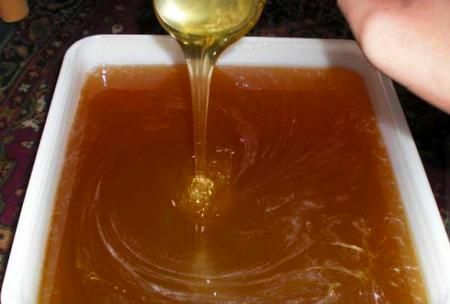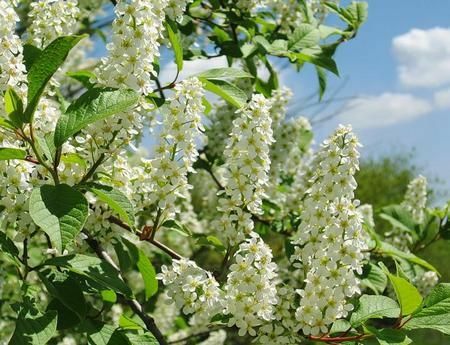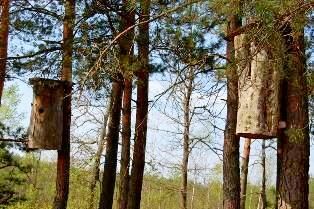Forest honey bees produce from nectar flowers of fruit trees, shrubs and flowers. Its unique slightly bitter taste is explained by the variety of honey-plants and the increased content of pada, in comparison with other varieties. This also ensures its high healing properties.
What is the difference between forest honey and other varieties?
The color of the forest nectar depends on the honeycombs from which it was harvested. The shade can vary from light yellow to dark, almost black. The taste has a specific, astringent, slightly bitter. The aroma absorbed all the forest motley grass with its refined and bright smells.
The "wild" honey differs in its composition. As a rule, it contains a lower amount of sugars, so it can be consumed by diabetics. A large amount of perga, royal jelly and propolis makes it the leader among other varieties for medicinal properties and the amount of nutrients. The pad, which is always present in such a product, provides it with a long crystallization period. She also gives him a slight bitterness in taste.
With long-term storage of forest honey forms an inhomogeneous mass with characteristic fine crystals. Under favorable conditions, it does not deteriorate for years and retains all its useful properties.
An interesting fact! The preserving properties of honey have been known since ancient times. Ancient people used it to store fast-spoiling products and mummification of deceased bodies.
Useful qualities of forest honey
Nectar collected from forest medicinal plants retains all their medicinal qualities. It has the following useful properties:
- anti-inflammatory
- analgesic
- immunostimulating
- fortified
- regenerating
- soothing
- antioxidant
- tonic.
As a healing tool among all varieties, it is best to use forest honey. Its useful properties have found application in the treatment of diseases such as:

- bronchitis
- angina
- stomatitis
- anemia
- vitamin deficiency
- hypertension
- insomnia
- of the stomach and intestines.
Daily use of this product in food helps to increase hemoglobin levels in the blood, reduce high blood pressure, improve blood circulation. Such qualities make it possible to classify forest honey as a preventive measure of cardiovascular diseases.
In the period of influenza epidemics, the use of such a drug can protect against viruses and reduce the risk of complications. For the treatment of colds, this nectar is the most valuable. Strengthen the magic of honey in support of immunity is able to lemon - together these magic ingredients will create a reliable protection for the body from respiratory infections. Several effective recipes with their use you will find in the article: Honey and lemon immunity strengthen, Diseases and weight are forever banished!
It is widely used in cosmetology, for rejuvenating masks, lifting, treatment of fungal diseases, skin diseases, metabolism and seborrhea.
During the Great Patriotic War, forest honey was used to disinfect and treat purulent wounds.
Tip! Buying honey at fairs and markets, do not hesitate to try it. This forest honey is always a little bitter and has an astringent taste.
How is forest honey produced?

In Russia, beekeeping - breeding of bees in forest hollows of trees, was known even before the 17th century. To do this, hang out special duplyanki, hollow out holes in the trunks of thick trees, used natural hollows, where the wild bee colonies were inhabited. Inside such beehives crosses were reinforced, on which honeycombs were subsequently built. Collection of honey occurred through narrow holes, chiseled specially for these purposes.
In our time, real onboard honey is rare. Basically, it is engaged in production in Bashkortostan, where the beekeeping was preserved. Most of the nectar, which we see in the markets and store shelves under the label "forest honey", is produced by cultivated bees, whose hives are placed in forest lands for the flowering period of grasses.
As a rule, the main fee starts in early July and ends in September. The most valuable honey collected by bees in May. It is considered the most useful and tasty.
Forest honey is never pure flower. It always has some amount of sweet, sweet substance, produced by insects living on trees. The composition of honey depends on its quantity. For the taiga are characteristic species varieties. In conditions of forest-steppe zones and high mountains, bees produce mixed, flower-pade honey.
An interesting fact! Wild bees are more efficient, compared to their home relatives. In the midst of the honey crop, one swarm is able to collect about 10 kg of nectar per day! Such reserve helps insects survive in severe Urals winters.
How the collection of honey honey occurs can be found in this video:
